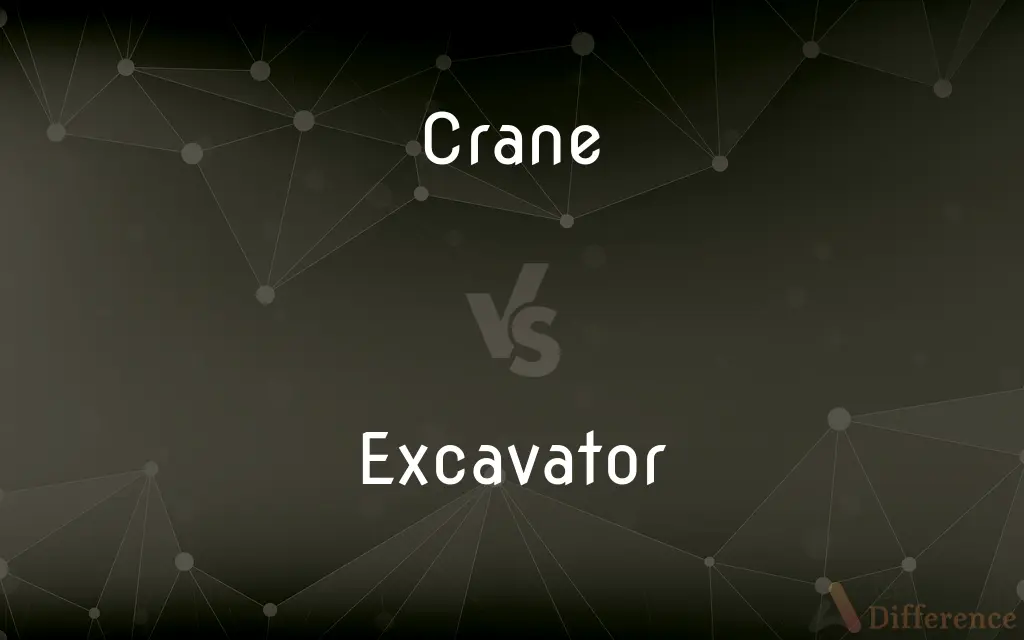Crane vs. Excavator — What's the Difference?
By Urooj Arif & Fiza Rafique — Updated on March 13, 2024
Crane is a machine designed for lifting and moving heavy loads, while an excavator is primarily used for digging and earth-moving.

Difference Between Crane and Excavator
Table of Contents
ADVERTISEMENT
Key Differences
Crane is a towering structure equipped with cables and pulleys for lifting and moving heavy materials in construction sites, ports, and industrial facilities. It operates through various mechanisms such as hydraulic, electric, or diesel-powered engines, providing vertical and horizontal movement to transport loads. On the other hand, an excavator is a versatile earth-moving machine that features a boom, stick, bucket, and cab on a rotating platform known as the "house." It is primarily used for digging trenches, holes, and foundations, but can also be used for demolition, heavy lifting, grading, and landscaping.
While cranes are specialized for lifting tasks with a focus on reaching high elevations or spanning large distances, excavators excel in ground-level operations involving digging and earth removal. The choice between a crane and an excavator depends on the specific requirements of the construction or industrial task at hand.
Cranes require significant setup time, especially tower cranes, which need to be assembled on-site, whereas excavators are more mobile and can start operation shortly after arriving at a site. This mobility makes excavators more versatile for a variety of projects, though their functionality is more focused on ground-level tasks.
In terms of operator skill, both machines require specialized training to ensure safety and efficiency. However, crane operation often involves more complex calculations related to load weight, wind conditions, and boom length, making it a highly specialized field. Excavator operators also need to master various techniques for digging, grading, and lifting, but the focus is more on maneuverability and precision in excavation tasks.
Comparison Chart
Primary Use
Lifting and moving heavy loads
Digging and earth-moving
ADVERTISEMENT
Operation
Vertical and horizontal movement
Rotational movement with digging action
Types
Tower, mobile, crawler
Crawler, wheeled, mini, long reach
Power Source
Hydraulic, electric, diesel
Mainly hydraulic
Suitability
High elevations, large distances
Ground-level tasks, versatile projects
Compare with Definitions
Crane
A machine designed for lifting and moving heavy loads, often seen in construction sites.
The crane lifted the steel beams to the top of the building.
Excavator
A heavy machine used primarily for digging and earth-moving tasks.
The excavator dug a trench for the new pipeline.
Crane
Utilizes cables and pulleys to facilitate movement.
The crane operator adjusted the pulleys to secure the load.
Excavator
Features a boom, stick, bucket, and cab on a rotating platform.
The excavator's boom reached deep into the ground to scoop up dirt.
Crane
Comes in various types such as tower, mobile, and crawler.
The construction site used a tower crane for its high vertical reach.
Excavator
Powered by hydraulic systems for digging and lifting.
The hydraulic power of the excavator made light work of the heavy rocks.
Crane
Requires specialized operator training for safe use.
Crane operators undergo rigorous training to handle complex lifting tasks.
Excavator
Essential in construction, mining, and road-building.
Excavators were used extensively in the highway expansion project.
Crane
Often used in ports for loading and unloading cargo.
The port's cranes were busy unloading containers from the ship.
Excavator
Can also be used for demolition and heavy lifting.
The excavator tore down the old building with its powerful bucket.
Crane
Any of various large wading birds of the family Gruidae, having a long neck, long legs, and a long bill.
Excavator
Excavators are heavy construction equipment consisting of a boom, dipper (or stick), bucket and cab on a rotating platform known as the "house". The house sits atop an undercarriage with tracks or wheels.
Crane
A similar bird, such as a heron.
Excavator
A person who excavates an archaeological site.
Crane
A machine for hoisting and moving heavy objects by means of cables attached to a movable boom.
Excavator
A large machine for digging and moving earth.
Crane
Any of various devices with a swinging arm, as in a fireplace for suspending a pot.
Excavator
One that excavates, especially a machine used for digging having a bucket attached to a two-part boom and a rotating cab for the operator.
Crane
To hoist or move with or as if with a crane.
Excavator
A person who excavates.
Crane
To strain and stretch (the neck, for example) in order to see better.
Excavator
A vehicle, often on tracks, used to dig ditches etc.Excavator
Crane
To stretch one's neck toward something for a better view.
Excavator
A curette used to scrape out pathological material.
Crane
To be irresolute; hesitate.
Excavator
One who, or that which, excavates or hollows out; a machine, as a dredging machine, or a tool, for excavating.
Crane
Any bird of the family Gruidae, large birds with long legs and a long neck which is extended during flight.
Excavator
A workman who excavates for foundations of buildings or for quarrying
Crane
Ardea herodias, the great blue heron.
Excavator
A machine for excavating
Crane
A mechanical lifting machine or device, often used for lifting heavy loads for industrial or construction purposes.
Crane
An iron arm with horizontal motion, attached to the side or back of a fireplace for supporting kettles etc. over the fire.
Crane
A siphon, or bent pipe, for drawing liquors out of a cask.
Crane
(nautical) A forked post or projecting bracket to support spars, etc.; generally used in pairs.
Crane
(obsolete) The cranium.
Crane
(ambitransitive) To extend (one's neck).
Crane
(transitive) To raise or lower with, or as if with, a crane.
Crane
(intransitive) To pull up before a jump.
Crane
A wading bird of the genus Grus, and allied genera, of various species, having a long, straight bill, and long legs and neck.
Crane
Any arm which swings about a vertical axis at one end, used for supporting a suspended weight.
Crane
A machine for raising and lowering heavy weights, and, while holding them suspended, transporting them through a limited lateral distance. In one form it consists of a projecting arm or jib of timber or iron, a rotating post or base, and the necessary tackle, windlass, etc.; - so called from a fancied similarity between its arm and the neck of a crane See Illust. of Derrick.
Crane
An iron arm with horizontal motion, attached to the side or back of a fireplace, for supporting kettles, etc., over a fire.
Crane
A siphon, or bent pipe, for drawing liquors out of a cask.
Crane
A forked post or projecting bracket to support spars, etc., - generally used in pairs. See Crotch, 2.
Crane
The American blue heron (Ardea herodias).
Crane
To cause to rise; to raise or lift, as by a crane; - with up.
What engines, what instruments are used in craning up a soul, sunk below the center, to the highest heavens.
An upstart craned up to the height he has.
Crane
To stretch, as a crane stretches its neck; as, to crane the neck disdainfully.
Crane
To reach forward with head and neck, in order to see better; as, a hunter cranes forward before taking a leap.
The passengers eagerly craning forward over the bulwarks.
Crane
United States writer (1871-1900)
Crane
United States poet (1899-1932)
Crane
Lifts and moves heavy objects; lifting tackle is suspended from a pivoted boom that rotates around a vertical axis
Crane
Large long-necked wading bird of marshes and plains in many parts of the world
Crane
Stretch (the neck) so as to see better;
The women craned their necks to see the President drive by
Common Curiosities
What is the primary function of a crane?
The primary function of a crane is to lift and move heavy loads vertically and horizontally.
What are the main uses of an excavator?
Excavators are mainly used for digging trenches, holes, foundations, and for demolition, grading, and landscaping.
Can cranes be used for digging purposes?
Cranes are not designed for digging; they are specialized for lifting and moving heavy materials.
What types of cranes are commonly used in construction?
Common types of cranes in construction include tower cranes, mobile cranes, and crawler cranes.
Are excavators capable of performing lifting tasks?
While primarily used for digging, excavators can perform lifting tasks within their capacity, especially with specific attachments.
How do excavators differ from cranes in terms of mobility?
Excavators are more mobile and can start operation shortly after arriving at a site, while cranes, especially tower cranes, require significant setup time.
What powers an excavator's digging and lifting actions?
Excavators are powered by hydraulic systems, which provide the necessary force for digging and lifting.
Can excavators be used in mining projects?
Yes, excavators are essential in mining projects for tasks such as earth-moving and digging.
Are there different types of excavators for specific tasks?
Yes, there are different types of excavators, such as crawler, wheeled, mini, and long reach, each suited for specific tasks.
How does the functionality of cranes and excavators differ?
Cranes are specialized for lifting and moving tasks, whereas excavators are focused on digging and earth removal.
Can cranes be electrically powered?
Yes, cranes can be powered by electric motors, especially in indoor or fixed installations, providing efficient and quiet operation.
What is the role of a crane in port operations?
In port operations, cranes are crucial for loading and unloading cargo from ships, facilitating efficient cargo handling.
What is the significance of the boom and bucket in an excavator?
The boom and bucket are crucial components of an excavator, used for reaching out, digging, and scooping up materials.
Is specialized training required to operate a crane?
Yes, operating a crane requires specialized training to ensure safety and efficiency, involving complex calculations and operational knowledge.
How do wind conditions affect crane operations?
Wind conditions can significantly impact crane operations, as they can affect the crane's stability and load movement, requiring careful consideration.
Share Your Discovery

Previous Comparison
Gestapo vs. SS
Next Comparison
Costume vs. HabitAuthor Spotlight
Written by
Urooj ArifUrooj is a skilled content writer at Ask Difference, known for her exceptional ability to simplify complex topics into engaging and informative content. With a passion for research and a flair for clear, concise writing, she consistently delivers articles that resonate with our diverse audience.
Co-written by
Fiza RafiqueFiza Rafique is a skilled content writer at AskDifference.com, where she meticulously refines and enhances written pieces. Drawing from her vast editorial expertise, Fiza ensures clarity, accuracy, and precision in every article. Passionate about language, she continually seeks to elevate the quality of content for readers worldwide.















































